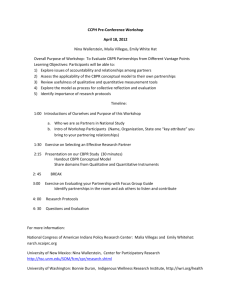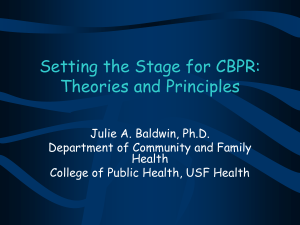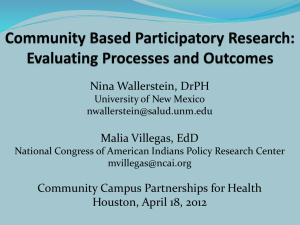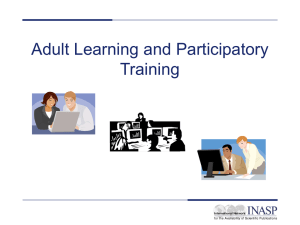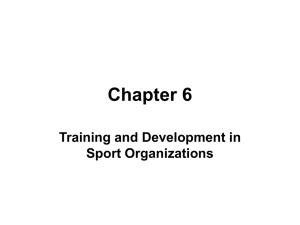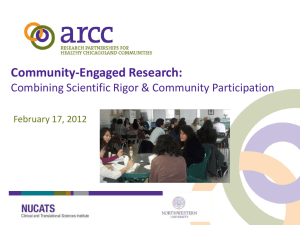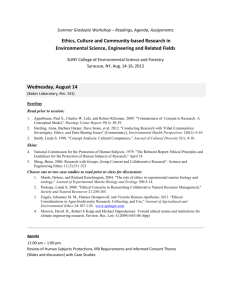Building Community Capacity
advertisement
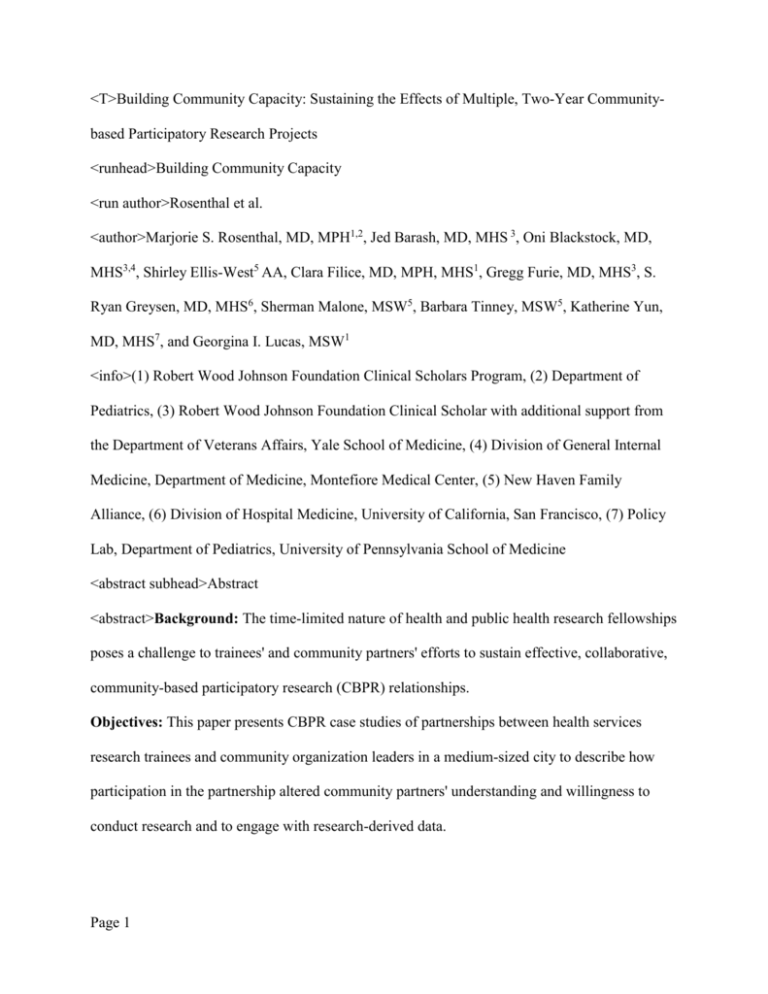
<T>Building Community Capacity: Sustaining the Effects of Multiple, Two-Year Communitybased Participatory Research Projects <runhead>Building Community Capacity <run author>Rosenthal et al. <author>Marjorie S. Rosenthal, MD, MPH1,2, Jed Barash, MD, MHS 3, Oni Blackstock, MD, MHS3,4, Shirley Ellis-West5 AA, Clara Filice, MD, MPH, MHS1, Gregg Furie, MD, MHS3, S. Ryan Greysen, MD, MHS6, Sherman Malone, MSW5, Barbara Tinney, MSW5, Katherine Yun, MD, MHS7, and Georgina I. Lucas, MSW1 <info>(1) Robert Wood Johnson Foundation Clinical Scholars Program, (2) Department of Pediatrics, (3) Robert Wood Johnson Foundation Clinical Scholar with additional support from the Department of Veterans Affairs, Yale School of Medicine, (4) Division of General Internal Medicine, Department of Medicine, Montefiore Medical Center, (5) New Haven Family Alliance, (6) Division of Hospital Medicine, University of California, San Francisco, (7) Policy Lab, Department of Pediatrics, University of Pennsylvania School of Medicine <abstract subhead>Abstract <abstract>Background: The time-limited nature of health and public health research fellowships poses a challenge to trainees' and community partners' efforts to sustain effective, collaborative, community-based participatory research (CBPR) relationships. Objectives: This paper presents CBPR case studies of partnerships between health services research trainees and community organization leaders in a medium-sized city to describe how participation in the partnership altered community partners' understanding and willingness to conduct research and to engage with research-derived data. Page 1 Methods: Trainees and faculty used participatory methods with community leaders to identify research questions, and conduct and disseminate research. Throughout the process, trainees and faculty included research capacity building of community partners as a targeted outcome. Community partners were asked to reflect retrospectively on community research capacity building in the context of CBPR projects. Reflections were discussed and categorized by the authorship team, who grouped observations into topics that may serve as a foundation for development of future prospective analyses. Results: Important ideas shared include that trainee participation in CBPR may have an enduring impact on the community by increasing the capacity of community partners and agencies to engage in research beyond that which they are conducting with the current trainee. Conclusion: We posit that CBPR with research trainees may have an additive effect on community research capacity when it is conducted in collaboration with community leaders and focuses on a single region. More research is needed to characterize this potential outcome. <abstract subhead>Keywords <abstract>Community-based participatory research, fellowship, education, capacity building, social network <info>Submitted 16 October 2012, revised 10 March 2013, accepted 23 May 2013 <N>CBPR is research wherein those who will be most affected by the outcomes of the research, those most capable of carrying out the proposed action from the research, and those with expertise in methods of research, all work together, learn from each other, and share resources with each other, to conduct research that can lead to actionable goals.1 Collaborations between community leaders and academic researchers in CBPR may be most productive when the partners’ relationship evolves to the point where they learn to understand and value each other’s Page 2 contribution to the partnership, a complex and time-consuming process.1-6 Resources dedicated to relationship building for a CBPR project may achieve the greatest value through sustained partnerships, where the skills acquired by each partner can be applied and advanced in further research.7 For the past 7years, faculty of the Yale Robert Wood Johnson Foundation Clinical Scholars Program (RWJF CSP) have been teaching and applying the principles of CBPR within a 2-year health services research traineeship for physicians.8,9 Because research trainees are in a phase of their career when they are learning about a myriad of research methods and approaches, by incorporating mentored CBPR into the curriculum, trainees may be more inclined, throughout their careers, to include the perspectives of all who will be impacted by their research.5,10-12 However, the time-limited nature of fellowship and the infrequency with which trainees maintain careers in the same communities in which they train can create challenges for the sustainability of CBPR projects. Although research trainees in time-limited fellowships may not engage in long-term partnerships with their community partners, trainee participation in CBPR may have an enduring impact on the community through the transfer of research capacity to community partners. Specifically, although trainees may be engaged in a CBPR project for only 2 years, trainees and faculty work to increase the research capacity of community partners to improve the health of the community they serve, long after the trainees have graduated. Although prior work has described the value and approach to research capacity building among community partners,4,13,14 none has described the research capacity building for community leaders associated with multiple, timelimited projects in the same city. Page 3 Accordingly, we sought to describe the research capacity building of community leaders partnering with academic trainees in CBPR in a single city. In this paper, we present CBPR case studies of research capacity building from our health services research trainees who partnered with community organization leaders in New Haven, Connecticut, a medium-sized urban community. <A>CBPR Training Approach for Research Trainees <N>All CBPR projects conducted through the Yale RWJF CSP include 1) a 40-hour classroombased curriculum, taught by faculty and community partners, 2) 16 hours of immersion experiences in the New Haven community, 3) tailored introductions to community leaders based on the trainee’s interest, 4) a 15- to 18-month CBPR project, and 5) oversight and mentoring from faculty and a steering committee on community projects. The steering committee has 22 members composed of representatives from New Haven health institutions (academic and community based), community-based organizations (CBOs), and university research centers partnering with New Haven-based CBOs. The steering committee meets monthly and provides guidance to trainees and community partners through networking, assessing the face validity of research hypotheses and proposed projects, and giving historical context.9,15 The 15- to 18-month project adheres to the principles of CBPR.4 Projects may be initiated by a community partner (who approaches CBPR faculty and asks to meet with research trainees), a research trainee (who brainstorms with CBPR faculty on whom to meet with in the community), or both during immersion experiences in the New Haven community.1,16 <A>Methods <N>The concept for this paper was proposed during a dissemination discussion in the Effects of Community Violence Case described herein. At that meeting, community partners suggested that Page 4 the Effects of Community Violence group should share with others how participation in the CBPR project had altered community partners' understanding and willingness to conduct research and to engage with research-derived data.17,18 The exercise described in this paper primarily served as an opportunity to reflect on community partners’ and academics’ experiences, and identify potential areas for future investigation; it was not designed to test prespecified hypotheses with standard qualitative analytic techniques. In composing this paper, the Effects of Community Violence team invited other community trainee CBPR teams to participate. As a larger group, we then each, respectively, referred to our research meeting and mentorship notes and other written communication within CBPR teams for observations relevant to community research capacity building. After collaboratively drafting an outline for this paper, the six academic trainees of these four cases asked their respective nine principal community partners to respond to the following questions: “How did collaborating with the RWJF Clinical Scholars on this project enhance your agency’s capacity to conduct and apply research to support your agency's mission? Specifically, what new skills, knowledge, and beliefs about the role of research did your agency acquire? Has participation in this project affected the way in which your agency will approach its mission in the future?" Academic partners asked their respective principal community partners these questions either face to face or by email, and followed up with clarifying questions as needed. Each academic and community partner team then discussed the meaning of the community partners’ answers. The partnered team then discussed the quotations and meaning with the larger authorship group who, through a process of discussion and consensus building, grouped the meaning statements into topics described in the cases and tables. At all times in this paper, the outcome of community capacity is described from community members’ and Page 5 academics’ perspective during and after the research project, and not from prospectively designed outcomes analyses. Community partners for each case chose to either co-author or approve the manuscript. The Yale Human Research Protection Program exempted this work from human subjects review. <A>Case Studies <B>Identifying Healthy, Affordable Food Options in an Urban Food Desert <N> Origin and description of the project. This 15-month project identified urban residents’ interest in alternative models of food distribution. The project team—the West River Food Group—consisted of two trainees, two board members of a neighborhood organization, two CBPR faculty, and three members of Yale School of Public Health’s Community Alliance for Research & Engagement. As part of the curricular immersion experiences in the local community, two research trainees and a CBPR faculty member went on a walking tour of the West River neighborhood of New Haven and attended a monthly meeting of the West River Neighborhood Services Corporation, a community organization of local residents. At the meeting, a board member described the lack of affordable, healthy food available to West River residents. The board member expressed the organization’s need to survey residents about their interest in alternative, neighborhood-based food distribution models to determine whether or not any of these models would be viable options for increasing access to healthy foods in West River. The two trainees recognized that the community organization had commitment and organization, and believed their research skills could add rigor to the resident survey (Table 1). <T>Table 1 Page 6 <N> Together they created the West River Food Group to develop and implement a survey of West River residents (Table 2). The survey assessed residents’ level of interest in three specific, alternative, neighborhood-based food models: A food cooperative, a buyer’s club, and a community-supported market. The survey findings describe West River residents’ challenges accessing affordable, healthy foods and identified high levels of interest in alternative, neighborhood-based food models. The West River Food Group disseminated the findings to residents, local officials, and other community agencies. As a result of the survey findings, a local nonprofit, whose focus is on local, sustainable food models, piloted a weekly farmer’s market in West River. <T>Table 2 <N> Ways in which the research capacity of community agency was enhanced. Two community partners participated in describing their experience. One community partner shared that he “learned a lot about assessment, how to actually derive questions, [and] ethical considerations [of research].” West River Neighborhood Services Corporation members are now applying these and other skills to other research projects (Table 3). In addition to building skills, one community partner described how participation in CBPR also resulted in a critical shift in norms and self-efficacy, such that systematic data collection is no longer viewed as the exclusive domain of academics. As one community partner observed, “From having engaged in the initial food polling process, it has created a new normal . . . for our grassroots organization to move forward in addressing the woes of our community with research and data.” Additionally, new relationships have been forged as a result of the community partners’ involvement in this study that will help facilitate their involvement in future research endeavors; the community partners Page 7 have become active in a network of community advocates, residents, and academics employing a CBPR approach to decrease neighborhood violence. <T>Table 3 <B>Understanding Community Violence From the Perspective of Adolescent Females <N> Origin and description of the partnership. In this multiyear project, trainees from two separate cohorts partnered with a CBO, New Haven Family Alliance, using photo elicitation with youth to gain a greater understanding of their perceptions of violence. The first research team consisted of five trainees, CBPR faculty, and a social worker, an outreach coordinator, and the executive director from the CBO; the second research team consisted of one trainee, CBPR faculty, two social workers, and the executive director. The project began when the executive director of New Haven Family Alliance approached CBPR faculty requesting help in evaluating the newly started Street Outreach Worker Program, a youth gun violence reduction project. In partnership, New Haven Family Alliance, trainees, and CBPR faculty designed a photo elicitation project to identify the perspectives of the youth impacted by youth gun violence.19 Consistent with photo-elicitation,20 the week before each of the 15 focus groups, youth participants took photographs reflecting their perception of the origins of violence and discussed the photographs in the focus groups. Community partners conducted the recruitment. Together, community and academic partners designed and co-facilitated the initial photo-elicitation focus groups and conducted analysis of the qualitative transcripts (Table 2). During the dissemination and discussion phase of the initial project, academic and community partners noticed a difference in how males and females experienced community violence but an in-depth analysis of that difference, and potential data-driven action, had yet to Page 8 be elucidated. A mutual desire to reexamine the transcripts to ascertain a greater understanding of the differences in perspective and experience by gender, and the matriculation of an interested trainee, led to the formation of the second CBPR team (Table 1). This team participated in gender-focused data analysis, interpretation, and dissemination (Table 2). Community partners are leading the on-going dissemination—through workshops and presentations—of both the initial project and the gender-specific project. Ways in which the research capacity of the community agency was enhanced. Three community partners participated in describing their experience. First, the community partners described new self-efficacy in doing research that they attributed, in part, to authentic engagement of the academic researchers. The community partners reported they were able to tackle the complex topic of gender and violence only because it took place “in an interpersonal context of mutual respect and trust . . . and personal risk-taking.” Whereas before the project one community partner had agreed to work on the project, saying, “We do not have time to do this but we know that if this isn’t done with us, academic researchers will do it without us.” The same community partner described that the CBO, since the experience of the CBPR project, was “comfortably” able to analyze and present client data to funders. The community partners described that they have better relationships with funding and state agencies because the community partners “understand the meaning behind the data.” The comfort with research has led two of the community partners to convene a city-wide, community–academic coalition to combat community violence, which applied for and received a grant from the National Institutes of Health (Table 3). For cases Transitions between Hospital and Homeless Shelter and Promoting Physical Activity and Safety using Health Impact Assessment, see Appendix A. <A>Discussion Page 9 <N>These cases illustrate enhancement of community research capacity through research trainee- and community partner-engaged CBPR. Specifically, we describe improved community research capacity in the domains of knowledge (e.g., knowing how to structure a research project, knowing about evidence in the literature regarding their topic of interest), attitudes (e.g., self-efficacy in doing research, belief that research adds value to work), skill development (e.g., adding health inquiries to other data collection, managing data, disseminating data to stakeholders and potential funders), and relationships formed (through sharing data and the potential power of data, each community partner formed a new relationship with a civic or community agency; Table 3). Our findings are consistent with prior assessments of CBPR that have described the value of research capacity building among community leaders.1,2,4,13 Our work extends previous investigations, in part, by considering the effects of research capacity building among community partners who work primarily within a single medium-sized city. Social network theory argues that mutable behaviors can be socially induced between connected individuals.21,22 Because the knowledge, attitudes, and behaviors associated with research capacity are mutable and potentially inducible between connected individuals, we posit that efforts to improve the research capacity of a few community leaders may improve research capacity for other community leaders within their professional social network, by having those with the selfperception of increased capacity building in positions where they may influence their peers. For example, the two West River Food Group community leaders described increasing their research capacity in the food insecurity project. As a result of the CBPR experience, the community partners from West River formed a collaboration with a local nonprofit and are working on a new project conducting surveys assessing public safety (Table 3). Having both key community Page 10 leaders describe accepting research as a meaningful approach to improve the lives of their clients, and having multiple CBPR opportunities in the same city may, together, serve to influence other community leaders, beyond those who have previously partnered with academics. Lessons learned from the implementation of the RWJF CSP CBPR curriculum may be useful for other academic training programs considering partnering with community agencies for CBPR. First, research capacity building worked for community leaders when it was tailored to the agency’s mission and a specific project. Before the work described herein, we had invited community leaders to take the same classroom-based curriculum with the research trainees. However, community leaders reported that research training for a specific project was more valuable. Second, we find that the ingredients necessary for teaching and facilitating CBPR include faculty who are 1) knowledgeable and committed to the principles of CBPR, 2) have resources to apply to projects, 3) have time funded to devote to teaching, mentoring, and relationship building in the community, and 4) are available to sustain enduring relationships with community leaders as the 2-year trainees matriculate and graduate. Third, in teaching research trainees, faculty recognize trainees’ diverse research interests; therefore, we frame our CBPR approach in the tenets of CBPR as well as in other methodologies with greater acceptance in health services and public health research, such as patient-centered outcomes and translational science.1,5 Finally, to help the trainees understand historical context and the mistrust community leaders may have of academic medical institutions, we promote cultural humility, teach communication skills, and facilitate an understanding of the role of personal identity and group membership in research.17,23,24 With this background, we then try to support relationship building Page 11 through transparent communication, negotiating through conflict, and clearly defining our respective expectations.2 Our description of community research capacity building through a health services research fellowship has limitations. As with any single-location characterization, lessons learned may be considered too idiosyncratic to the specific circumstances in which the cases took place. However, many academic institutions with health services and public health research fellowships are within medium-sized communities and may be able to achieve similar results. Second, we do not describe the process of CBPR capacity building for research trainees; their willingness to engage in partnered research necessitates taking on new roles, and this topic is worthy of exploration.11 Third, our idea that social network theory might play a role in extending community partners’ capacity building to those in their professional social network is speculative; social network analysis is necessary to confirm or deny this possibility. Fourth, although transience in CBO leadership may present a problem in community capacity building, the leadership at most of the community sites has been stable throughout the 7 years of our partnerships. Even at the homeless shelter in the Transitions between Hospital and Homeless Shelters Case, where one community partner left soon after the project was completed, another community partner stayed and the institutional memory of the value of research seems to have been sustained as evidenced by further community–academic trainee partnered work on medical respite care for homeless patients.25 Finally, we do not describe a systematic, prospective measurement of the impact of CBPR on the research capacity of community agencies, but rather describe the perceptions of community partners and academics after successful research projects. A prospective study of capacity building would likely include failed partnerships and lack of capacity building and is a necessary step in this line of inquiry. However, in all four cases Page 12 described, the community agencies have initiated new research roles for their agency, an important impact of CBPR. In summary, although achieving sustainable change may be difficult for trainees conducting CBPR in a 2-year academic research training program, we describe a process whereby community research capacity building within a professional social network may make sustained change possible. Specifically, we describe how multiple, time-limited CBPR projects each contributed to the development of research capacity among community partners. As a result, partners report having applied new research expertise to novel projects, some of which were specific to their agency and some of which draw partners from their larger professional network. These efforts may contribute to other people in their professional network accepting research as a valid means of improving the health of community members. Therefore, faculty and trainees, seeking to optimize their contribution to improving health through CBPR, may be most effective by conducting CBPR with community leaders in a single community, placing an emphasis on research capacity building, and thus building a network of community leaders capable of conducting health services and public health research. <A>Acknowledgments <N>The authors acknowledge all of the community partners and trainees who have participated in the CBPR curriculum, including teachers, learners, walking tour guides, advisors, steering committee members, and researchers. <A>References <ref>1.Minkler M, Wallerstein N, eds. Community-based participatory research for health: From process to outcomes. San Francisco: Jossey-Bass; 2008. Page 13 2. Christopher S, Watts V, McCormick AK, Young S. Building and maintaining trust in a community-based participatory research partnership. Am J Public Health. 2008;98:1398-406. 3. Jagosh J, Macaulay AC, Pluye P, Salsberg J, Bush PL, Henderson J, et al. Uncovering the benefits of participatory research: Implications of a realist review for health research and practice. Milbank Q. 2012;90:311-46. 4. Israel BA, Coombe CM, Cheezum RR, Schulz AJ, McGranaghan RJ, Lichtenstein R, et al. Community-based participatory research: A capacity-building approach for policy advocacy aimed at eliminating health disparities. Am J Public Health. 2010;100:2094-102. 5. Wallerstein N, Duran B. Community-based participatory research contributions to intervention research: The intersection of science and practice to improve health equity. Am J Public Health. 2010;100 Suppl 1:S40-6. 6. Pivik J, Goelman H. Evaluation of a community-based participatory research consortium from the perspective of academics and community service providers focused on child health and well-being. Health Educ Behav. 2011;38:271-81. 7. Carroll-Scott A, Toy P, Wyn R, Zane J, Wallace S. Results from the Data & Democracy initiative to enhance community-based organization data and research capacity. Am J Public Health. 2012;102:1384-91. 8. Dalal M, Skeete R, Yeo HL, Lucas GI, Rosenthal MS. A physician team's experiences in community-based participatory research: Insights into effective group collaborations. Am J Prev Med. 2009;37:S288-91. 9. Rosenthal MS, Lucas GI, Tinney B, Mangione C, Schuster MA, Wells K, et al. Teaching community-based participatory research principles to physicians enrolled in a health services research fellowship. Acad Med. 2009;84:478-84. Page 14 10. Meyers FJ, Begg MD, Fleming M, Merchant C. Strengthening the career development of clinical translational scientist trainees: A consensus statement of the Clinical Translational Science Award (CTSA) Research Education and Career Development Committees. Clin Transl Sci. 2012;5:132-7. 11. Gourevitch MN, Jay MR, Goldfrank LR, Mendelsohn AL, Dreyer BP, Foltin GL, et al. Training physician investigators in medicine and public health research. Am J Public Health. 2012;102:e39-e45. 12. Arrighi JA. Educational initiatives for quality improvement projects: Can you teach an old dog new tricks? Circulation. 2011;123:471-3. 13. Cashman SB, Adeky S, Allen AJ, 3rd, Corburn J, Israel BA, Montaño J, et al. The power and the promise: working with communities to analyze data, interpret findings, and get to outcomes. Am J Public Health. 2008;98:1407-17. 14. Amico KL, Wieland ML, Weis JA, Sullivan SM, Nigon JA, Sia IG. Capacity building through focus group training in community-based participatory research. Educ Health (Abingdon). 2011;24:638. 15. Bilodeau R, Gilmore J, Jones L, Palmisano G, Banks T, Tinney B, et al. Putting the "community" into community-based participatory research. A commentary. Am J Prev Med. 2009;37:S192-4. 16. Robert Wood Johnson Foundation Clinical Scholars [updated 2013; cited 2013 Feb 22]. Available from: http://rwjcsp.unc.edu/. 17. Minkler M, Wallerstein N, eds. Community-based participatory research for health: From process to outcomes. Second edition. San Francisco: Jossey-Bass; 2008. Page 15 18. Bordeaux BC, Wiley C, Tandon SD, Horowitz CR, Brown PB, Bass EB. Guidelines for writing manuscripts about community-based participatory research for peer-reviewed journals. Prog Community Health Partnersh. 2007;1:281-8. 19. Understanding youth violence in New Haven: A photovoice project with youth of New Haven. New Haven: New Haven Family Alliance and the Robert Wood Johnson Clinical Scholars Program at Yale Medical School; 2009 [cited 2012 Jun 27]. Available from: http://ctdatahaven.org/know/images/f/f4/RWJF_Photovoice_Report_YouthViolence_2009.pdf. 20. Griffin C, Hunter J, Phoenix A. Young people's constructions of self: Notes on the use and analysis of the photo-elicitation methods. Int J Soc Res Methodol. 2008;11:12p. 21. O'Malley AJ, Christakis NA. Longitudinal analysis of large social networks: Estimating the effect of health traits on changes in friendship ties. Stat Med. 2011;30:950-64. 22. Christakis NA, Fowler JH. The spread of obesity in a large social network over 32 years. N Engl J Med. 2007;357:370-9. 23. Tervalon M, Murray-Garcia J. Cultural humility versus cultural competence: A critical distinction in defining physician training outcomes in multicultural education. J Health Care Poor Underserved. 1998;9:117-25. 24. Smith KK, Berg DN. Paradoxes of group life: Understanding conflict, paralysis, and movement in group dynamics. San Francisco: Jossey-Bass; 1987. 25. Doran KM, Ragins KT, Gross CP, Zerger S. Medical respite programs for homeless patients: A systematic review. J Health Care Poor Underserved. 2013;24:499-524. Page 16 <table number>Table 1. <table title>Community-based Participatory Research Project Characteristics <table> Project Name Project Community Additional Project’s Impact Objectives Partners Stakeholders Transitions Understand the Columbus House Clients of Columbus House between experiences of Executive Columbus House, now incorporates Hospital and homeless director and YNHH health status into its Homeless individuals Columbus House Department of intake process; Shelter* during Director of Social Work, meeting with YNHH transitions from Programs New Haven City to improve discharge the hospital to Homeless planning the homeless Council, Cornell- conversations with shelter; Scott Hill Health hospital emergency determine Center (a department to better aspects of these federally qualified communicate transition that community health housing would result in center), Yale arrangements of higher quality Homelessness admitted patients; transitions; and Hunger demonstration create an action Action Panel project to offer plan to improve respite beds at better quality of Columbus House care transitions West River Assess the level Two Residents of West Stimulated CitySeed Food of interest of representatives River and to pilot a weekly Insecurity West River of the West surrounding farmer’s market in residents in River communities; West River; raised alternative, Neighborhood CitySeed and awareness of food neighborhoodServices other programs insecurity in West based food Corporation advocating for River and other models (e.g., sustainable neighborhoods food agriculture and cooperatives, nutritious, communityaffordable food in supported New Haven; three markets); members of the advocate for Yale School of increased access Public Health’s to affordable, Community quality healthy Alliance for foods Research & Engagement Promoting Improve health Representatives Residents of local Interim plans Physical outcomes related from New Haven neighborhoods; consistent with some Activity and to the Downtown Departments of local cycling and proposed Page 1 Safety using Health Impact Assessment* Effects of Community Violence on Females Crossing project; demonstrate the utility of HIA as a tool to inform decision making in local projects and policies; train other New Haven health advocates to perform HIAs To characterize the perspective and experience of girls living in areas of high violence Health, City Plan, Transportation, Economic Development; local data sharing organization representative pedestrian advocacy groups; workers and commuters to the medical district and Yale University; academic, civic, and community health advocates NHFA executive director; two NHFA service providers Neighborhood groups; high school health education classes; NHFA clients; parents and professionals working with teenage girls recommendations; evidence collected for this HIA served to support city requests for healthcentric design exceptions from state transportation officials New classes and workshops for girls on healthy relationships both at NHFA and throughout city high schools using the guidebook created by the research team, “Reflecting on Teen Girls’ Experience with Violence” <table note>HIA, Health Impact Assessment; NHFA, New Haven Family Alliance; YNHH, Yale–New Haven Hospital. *Case in Appendix, only. Page 2 <table number>Table 2 <table title>Key Roles of Community Partners and Research Trainees in the Community-based Participatory Research Projects <table> Project Community Partners Research Trainees Name Transitions Engaged Columbus House staff in Conducted literature search upon which between providing input to survey; analyzed and to base survey; trained research Hospital and interpreted the open ended survey assistants; sought out hospital partners Homeless questions; co-led data dissemination to be stakeholders in intervention; Shelter* meetings with Columbus House staff analyzed closed ended survey and hosptial stakeholders (social work, questions; analyzed and interpreted the quality operations, chief of staff) open ended survey questions; co-led data dissemination meetings with Columbus House staff and YNHH stakeholders (social work, quality operations, chief of staff) West River Developed initial survey questions; Modified and added survey questions; Food piloted survey with community piloted survey with community Insecurity residents; recruited participants; residents; performed descriptive and conducted surveys; presented findings content analyses of survey responses; to West River residents; reviewed and presented findings to West River disseminated executive report to residents; prepared an executive report community and city leaders detailing findings Promoting Defined health outcomes of interest; Defined health outcomes of interest; Physical identified where public health evidence collected and analyzed baseline Activity and could address knowledge gaps; sociodemographic and health data; Safety using provided input on level of analysis and identified potential environmental audit Health data sources for baseline assessment; tools; conducted environmental audits; Impact shared relevant city data; guided conducted relevant background Assessment* workgroup in selection of literature review; identified evidenceenvironmental audit tool; reviewed based interventions to optimize health available evidence and outcomes; prepared maps and wrote recommendations to determine if 1) report summarizing process and they addressed knowledge gaps and 2) outcomes; disseminated HIA findings conclusions were well founded; in academic and community settings; reviewed and edited HIA report coordinated and led HIA training summarizing process and outcomes Effects of Co-led photo-elicitation focus groups; Co-led photo-elicitation focus groups; Community conducted qualitative analysis of focus conducted qualitative analysis of focus Violence on group transcripts; disseminated data group transcripts; trained community Females through workshops on “Healthy partners in qualitative research; Relationships” conducted literature review of violence and gender; disseminated data by preparing an academic manuscript <table note>HIA, Health Impact Assessment; YNHH, Yale–New Haven Hospital. *Case in Appendix, only. Page 3 Page 4 <table number>Table 3. <table title>Perceived Impact of Participation in Community-based Participatory Research on Community Agency <table> Project Knowledge Beliefs/Attitudes Application of Relationships Name Transferred About Research Acquired Skills to Formed as Result New of Participation Projects/Contexts Transitions What it takes to Adds value to the Consistently YNHH Social between conduct organization’s collect health Work and Hospital and research; how to operations and information during Emergency Homeless structure a ability to attract client intake Medicine Shelter* research project; funds for new process; analyze Departments; tools that might programs; helped health data and stronger be available to Columbus House share with relationship with do research take a realistic funders; designing federally qualified look issues evaluation of a community health between homeless respite bed center and healthcare demonstration project West River Survey Created a new Surveys assessing Collaboration Food development; norm that research public safety between West Insecurity sampling can be applied to River and CitySeed methods; address issues interview relevant to the techniques community; instilled sense that research can strengthen community projects Promoting HIA Raised awareness Health New collaboration Physical methodology; of need to Department between the Health Activity and awareness of consider health in application for Department and Safety Using public health all policies; city CDC grant to City Plan, Health evidence to partners support HIA; HIA Transportation, Impact support city considering ways incorporated into Economic Assessment* planning to conduct HIA city work plan Development decision making; for future projects; Departments use of community health environmental advocates surveys to considering HIA inform planning as a way to decisions promote health Effects of How to conduct Self-efficacy with Facilitating cityBetter relationships Community qualitative ability to collect, wide violence with funding Violence on analysis; how to synthesize, prevention project, agencies and state-Page 5 Females disseminate and including applying willing to be the use data to inform for NIH grant as a point person on programming; co-PI; “Healthy assessments demystified Relationships” research process; infusing all increased comfort programming with building throughout the coalition of agency and academics and outreach efforts community members <table note>CDC, U.S. Centers for Disease Control and Prevention; HIA, Health Impact Assessment; NIH, National Institutes of Health; PI, principal investigator; YNHH, Yale–New Haven Hospital. *Case in Appendix, only. Page 6 present data for different audiences Rosenthal <A>Appendix A: Understanding Transitions Between Hospital to Homeless Shelter <B>Origin and Description of the Project <N>This was an 18-month project that investigated the perceptions of homeless individuals regarding transitions of care between the hospital and homeless shelters. The project team consisted of a trainee, staff from a homeless shelter, Columbus House, and Community-based Participatory Research (CBPR) faculty. When the trainee started fellowship, he expressed his interest in working with homeless individuals. He and CBPR faculty discussed the groups in New Haven whose mission it was to improve the lives of homeless individuals. He met with city officials and CBOs serving the homeless, including the Director of Programs at Columbus House. Columbus House provides temporary, short-term and long-term housing and hosts a medical clinic one half day each week. The trainee and the Director of Programs realized they both wanted to improve transitions of care for homeless individuals being discharged from area hospitals, but the available data on transitions of care did not include the perspective of homeless individuals. The trainee and Director of Programs explored the perspective of homeless individuals through a semi-structured survey of Columbus House clients. To understand patterns of care for these patients, they also analyzed medical records from participants’ recent hospital or emergency department admission (Table 1). The semi-structured survey, adapted from the literature and modified with input from stakeholders, contained questions on the length of homelessness, number of emergency department and hospital admissions, care received during admission, and hospital discharge care. The survey also included two open ended questions where participants could describe their experiences.18 Together, the community partner and research trainee conducted the analysis and then disseminated the findings to the social workers, quality improvement officers and the Chief [Insert Running title of <72 characters] Rosenthal of Staff at the region’s largest hospital; city and state elected officials; state-level government agencies; and state and national non-profit agencies (Table 2). As a result of the project, Columbus House has added a health status assessment to client intake and is working with the university hospital to improve transitions of care. <B>Ways in Which the Research Capacity of Community Agency Was Enhanced <N>Two community partners participated in describing their experience. The Executive Director of Columbus House reflected, “We now know better how to think about research, what it takes to conduct a project, how to structure a research project, and what tools might be available to us if we were to do research on our own.” The Director of Programs described the impact of the research project on the agency: “We started looking at how data could improve programs; it sped up the inevitable process of embarking on the task of completing a community-wide Vulnerability Index Survey. We incorporated questions about health status into our Satisfaction Survey. It raised our awareness on how to use data and that it didn't need to be a complicated task.” Based on this experience, Columbus House is now designing an evaluation of a respite bed demonstration project (Table 3). [Insert Running title of <72 characters] Rosenthal <A>Appendix B: Promoting Pedestrian and Cyclist Physical Activity and Safety Using a Health Impact Assessment <B>Origin and Description of the Project <N>This was a 16-month project conducting a Health Impact Assessment (HIA) on a proposed urban highway redevelopment project. The HIA team consisted of two trainees, CBPR faculty, the Executive Director of an organization that seeks to be a clearing house for locally relevant reports and data, and members of the New Haven Departments of City Planning, Economic Development, Transportation, and Public Health. In the classroom-based CBPR curriculum, two trainees with an interest in the built environment and physician advocacy learned about Health Impact Assessment, a systematic, evidence-based approach used to project health impacts and optimize health outcomes of public projects.19,20 Concurrently, during a meeting with a community group, the two trainees learned about a proposed urban highway removal project in the city and considered applying HIA to the project. The trainees learned that the highway removal project will replace a short stretch of urban highway with local streets and ten acres of developable land. The current highway serves as an imposing barrier to bicycle and pedestrian activity between adjacent residential neighborhoods, downtown, and a large hospital complex. The area around the highway is densely populated with residents and workers with a high prevalence of health conditions associated with physical inactivity. CBPR faculty introduced the trainees to City of New Haven department leaders. In collaboration with these department leaders, the trainees convened the project team to conduct the HIA. The collaboration focused on promoting pedestrian and bicyclist physical activity and reducing unintentional injury (Tables 1, 2).21 [Insert Running title of <72 characters] Rosenthal <B>Ways in Which the Research Capacity of the Community Agency Was Enhanced <N>Two community partners participated in describing their experience. By conducting an HIA on a relevant and timely New Haven transportation project, the project partners became familiar with the HIA process and how HIA could be used to promote health in the context of projects and policies outside traditional health sectors (Table 3). The City of New Haven department leaders, a key set of decision-makers, may recognize and consider the benefit of future HIAs when new public projects are still in the design phase. One city department leader reported, “The collaboration ... on the HIA study was useful in accessing research that we knew (or hoped) was out there but had neither the time nor the experience with the sources to find and review.” Furthermore, the leader reported the city “may seek out grants or partners in the future to do similar studies.” In addition to introducing HIA as a methodology to project partners, the two trainees hosted 37 civic, community and academic health advocates for a two-day HIA training led by national HIA experts. At the training, participants learned about the HIA process, considered the application of HIA for two New-Haven specific case studies, and generated ideas for HIA’s future application in the city. Subsequent to the initiation of this first HIA in New Haven, there has been increasing interest in HIA. A multidisciplinary coalition of New Haven leaders including members of the HIA workgroup is working to formally incorporate HIA into its work plan as a method to evaluate the neighborhood and population health impacts of all policy decisions in the city. Furthermore, following participation in this HIA, the New Haven Department of Public Health applied for federal funding to conduct HIAs. [Insert Running title of <72 characters]
